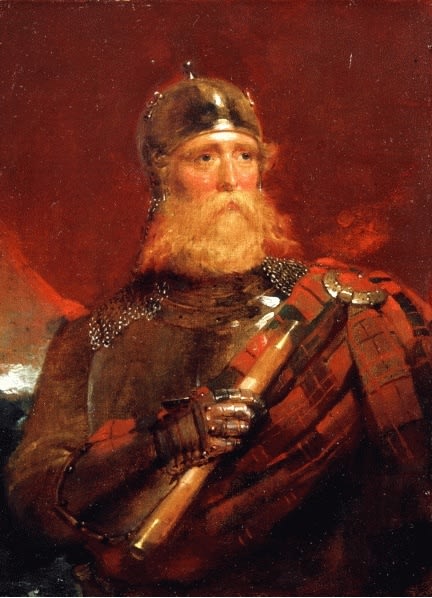
Kenneth Macleay RSA
Portrait of a Highland Chieftain, 1870
Oil on canvas
9½ x 7 in. (23.25 x 17.7 cm)
Philip Mould & Co.
To view all current artworks for sale visit philipmould.com Macleay is best known for his watercolour and miniature portraits of Scottish sitters, and for The Highlanders of Scotland, a...
To view all current artworks for sale visit philipmould.com
Macleay is best known for his watercolour and miniature portraits of Scottish sitters, and for The Highlanders of Scotland, a complete illustrated record commissioned by Queen Victoria. of her Scottish retainers and clansmen. He also produced a number of oil paintings of more generalised and historical Highland subjects. The present painting is an example of these. Although exhibited in 1870 under the title of Portrait of a Highland Chief the subject is more elevated than that mere description implies. The direct source for this majestic image of a warrior general is a painting of King Robert the Bruce by George Jameson c. 1618, which was executed as one of a series of heroes and great Scottish kings for a pageant. The image with its distinctive helmet and fierce characterisation was engraved numerous times during the eighteenth and nineteenth centuries, until it acquired a somewhat iconic status.
Macleay employs the variant of a marshal’s baton to the battle-axe in the Jameson painting, but he enhances the sense of defiance and resolution suggested in the king’s expression. The execution shows the painter’s competence in the medium, and although the small scale is typical of the artist’s commissioned watercolour portraits, there is a presence and a grasp of drama that approaches the Scottish romanticism of John Pettie.
Macleay is best known for his watercolour and miniature portraits of Scottish sitters, and for The Highlanders of Scotland, a complete illustrated record commissioned by Queen Victoria. of her Scottish retainers and clansmen. He also produced a number of oil paintings of more generalised and historical Highland subjects. The present painting is an example of these. Although exhibited in 1870 under the title of Portrait of a Highland Chief the subject is more elevated than that mere description implies. The direct source for this majestic image of a warrior general is a painting of King Robert the Bruce by George Jameson c. 1618, which was executed as one of a series of heroes and great Scottish kings for a pageant. The image with its distinctive helmet and fierce characterisation was engraved numerous times during the eighteenth and nineteenth centuries, until it acquired a somewhat iconic status.
Macleay employs the variant of a marshal’s baton to the battle-axe in the Jameson painting, but he enhances the sense of defiance and resolution suggested in the king’s expression. The execution shows the painter’s competence in the medium, and although the small scale is typical of the artist’s commissioned watercolour portraits, there is a presence and a grasp of drama that approaches the Scottish romanticism of John Pettie.
Provenance
Archibald Kerr, Loch LomondExhibitions
Royal Scottish Academy 1870 (no. 68)
Be the first to hear about our available artworks
* denotes required fields
We will process the personal data you have supplied in accordance with our privacy policy (available on request). You can unsubscribe or change your preferences at any time by clicking the link in our emails.